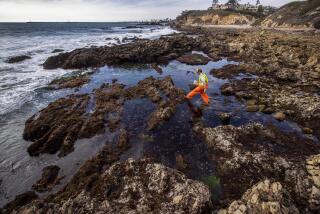Wisconsin oil spill is Canadian firm’s worst since 2010 disaster
- Share via
ANN ARBOR, Mich. — Enbridge, a beleaguered Canadian oil pipeline company, has spilled more than 50,000 gallons of light crude oil in rural Wisconsin -- shortly after the company said it had implemented safety reforms after a massive 2010 spill in Michigan.
Officials for Alberta-based Enbridge Inc., one of the United States’ most vital suppliers of Canadian oil, said Friday’s spill has been contained by cleanup workers, who are now trying to repair and restart the 24-inch pipeline known as Line 14, which carries more than 300,000 barrels a day.
The incident is another black mark for an ambitious energy company ridiculed earlier this month by U.S. safety officials, who likened Enbridge workers to the Keystone Kops. The comparison came after an investigation of a broken pipeline that released more than 800,000 gallons of heavy crude near Marshall, Mich. -- one of the largest inland oil spills in U.S. history and certainly the most expensive.
The new spill, in sparsely populated Adams County, Wis., forced the evacuation of two homes. It is the company’s worst spill since the 2010 disaster, and it drew the ire of U.S. Rep. Ed Markey (D-Mass.), ranking member of the House Natural Resources Committee.
“Enbridge is fast becoming to the Midwest what BP was to the Gulf of Mexico, posing troubling risks to the environment,” Markey said in a statement. “The company must be forthcoming about this entire incident, and deserves a top-to-bottom review of their safety culture, procedures and standards.”
According to Enbridge company data collected by the Polaris Institute, a Canadian think tank, Enbridge pipelines have spilled 804 times since 1999 and leaked 6.8 million gallons of oil. In response to a U.S. National Transportation Safety Board investigation blasting the company for its actions during the Michigan spill, the company said it had made “numerous enhancements” to safety procedures.
Enbridge spokeswoman Lorraine Little told the Los Angeles Times that federal and company investigators were already looking into the accident but that no explanation was available yet. “It’s too soon to tell at this point,” she said.
She said Enbridge had performed two inspections on Line 14 in the past year and used “in-line” scans to look for flaws in the line — kind of like an MRI that would reveal cracks and defects that could become problematic — but she did not have information on the results of those inspections, saying it would come out as part of the forthcoming investigations.
Under federal regulations, pipelines are allowed to have a certain amount of imperfections without requiring an immediate replacement. Enbridge has come under fire in previous major spills, such as in Marshall, for detecting flaws in their pipelines but failing to fix them before they break.
Wisconsin state records also show that Enbridge was about to conduct a “routine” but invasive inspection and maintenance on its pipelines where the spill happened. According to a report filed with the Wisconsin Department of Natural Resources, the company had asked permission to dig 10-foot-deep, 60-foot-long, 30-foot-wide trenches to examine four of its pipelines that run side-by-side.
Little, the Enbridge spokeswoman, said she was unaware of the proposed maintenance work in Adams County.
The request said the Enbridge pipelines run through the natural habitat of the Western slender grass lizard, an endangered species in Wisconsin, so the company had to wait for public comment for the inspection plan to be approved. The final day in the public comment process was Friday, the day of the spill.
Now the work is going ahead. “They’ve got enough equipment down here to build a freeway,” Patrick Swadish, who lives than a mile from the spill, told The Times. He said two of his neighbors had been evacuated, including a woman living next to the spill site.
All the pooled oil has been cleaned up, said Patricia Klinger, a spokeswoman for the U.S. Pipeline and Hazardous Materials Safety Administration, which has two inspectors on-site.
As opposed to the disastrous Michigan spill, Enbridge said its employees immediately shut down the pipeline when the company’s pipeline command center received alerts about a possible spill at 2:45 p.m. Central time. It then took 2 1/2 hours to notify the National Response Center, whose guidelines say pipeline operators “must notify NRC immediately after he or she has knowledge of the discharge.”
According to National Response Center data, Enbridge has had a similar lag time in reporting previous hazardous spills.
But company spokeswoman Little said it takes time for pipeline operators to estimate how much oil has spilled before reporting to the National Response Center, a kind of federal disaster-response 911. The center reported the Wisconsin spill to more than 25 government agencies within 15 minutes of receiving Enbridge’s report.
National Response Center data shows that the new Enbridge spill in Wisconsin is the company’s worst in that state.
More to Read
Sign up for Essential California
The most important California stories and recommendations in your inbox every morning.
You may occasionally receive promotional content from the Los Angeles Times.










